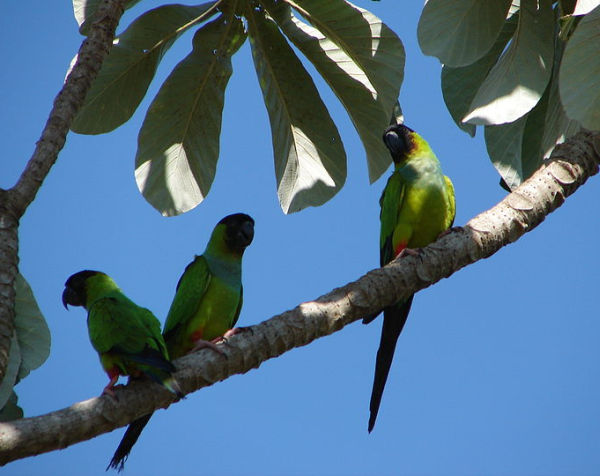
Last Thursday at Wakodahatchee Wetlands, Florida I heard the screech of birds calling in flight. The sound reminded me of terns so I searched the sky for large white birds but couldn’t find any. Then I remembered. That’s the sound of parakeets.
In western Palm Beach County escaped or released monk parakeets (Myiopsitta monachus) have gone wild. In the four hours I spent at the wetlands I counted at least 20 flying by but they never landed.
Later at Boynton Beach Inlet I found a large flock of black-hooded parakeets (Aratinga nenday), native to South America and pictured above. They loafed on the wires above the park and frequently commented on the world going by. Some perched in pairs shoulder to shoulder, leaning against each other and allo-preening. When other parakeet flocks approached, the large flock screeched a greeting so the others would join them. Eventually the flock numbered at least 75 birds. They grew restless and circled up and away.
Two hundred years ago there were parakeets in Pennsylvania, but no more. When Europeans first came to this continent the Carolina parakeet ranged from New York to Florida, from eastern Kansas to the east coast. But the birds quickly left when settlers arrived on the scene, even when suitable habitat remained. Perhaps the birds were smart to leave. The settlers killed them for their beautiful feathers and as fruit-tree pests.
Eventually the pressure of human encroachment took its toll on the Carolina parakeet. By 1878 the only colonies east of the Mississippi were in remote parts of Florida. By 1918 the last known bird died at the Cincinnati Zoo.
Interestingly the monk parakeet is winter-hardy and has established feral colonies as far north as Brooklyn (NYC), Chicago and Connecticut. They could live in Pennsylvania but the state considers them agricultural pests and it is illegal to sell or own them.
And so we will never know what it was like when wild parakeets roamed Pennsylvania. In Florida you can get a taste of it.
(photo of black-hooded parakeets in Brazil, from Wikipedia. Click on the photo to see the original)
“They loafed on the wires above the park and frequently commented on the world going by.” I have a Nanday, and you have described them perfectly. Mine does the same thing in the living room–loafing and commenting. 🙂
speaking of wild parakeets, I recently read a very interesting book called “The Wild Parrots of Telegraph Hill (In San Francisco) by Mark Bittner — a true story that actually was made into a video for TV. Mark Bittner was homeless and adrift, then he encounters this flock of parrots and one by one, gets to know the individual birds, which are fascinating creatures.
Thanks for mentioning it, Libby. I read the book & saw the movie and loved both of them!
I just saw “The Wild Parrots of Telegraph Hill” this morning on PBS World/Independent Lens. It was great! It reminded me of this blog entry, so I just had to put a post on!
There will be several showings of “The Wild Parrots of Telegraph Hill” on different PBS stations at different times, TODAY through 1-3-11.
Here is the link to the stations and times: http://www.pbs.org/independentlens/broadcast.html
Reading your post about the Florida Monk Parakeets brought back memories of a pair that nested in Pittsburgh in 1972-73. We never found out who released them or where they might have escaped from captivity.
The huge nest was built on the top of a utility pole in Brookline, and the birds attracted a lot of attention. Most people (not including the electric company folks, I imagine) were disappointed to see them vanish.
Dave Freeland, a former Audubon Society of Western Pennsylvania president, summarized his own and other observers’ reports in the Audubon Society of Western Pennsylvania Bulletin.
It’s a short story with an abrupt ending:
Summer 1972 — “Monk Parakeets bred in Pittsburgh’s Brookline section, raising at least one young bird which was on the wing with the pair of adults throughout August.”
September 1972 –“The family of Monk Parakeets at Brookline was determined to include 2 adults and 3 young; a fourth young bird is possible there.”
October 1972 — “Two adults and 3 immature Monk Parakeets continued in Pittsburgh’s Brookline section throughout October.”
November 1972 — “Two adult and 3 immature Monk Parakeets continued in Pittsburgh’s Brookline section throughout the month.”
January 1973 – “The Brookline pair of Monk Parakeets continued through January but the 3 young were no longer observed.”
March 1973 — “The Brookline Monk Parakeets constructed a second nest section to their original structure, and all 5 birds survived the winter.”
April 1973 — “The Brookline Monk Parakeets — 5 all told — began occupying both parts of a two-compartment nest.”
Summer 1973 — “The Brookline family of 5 Monk Parakeets disappeared in early June.”
The End